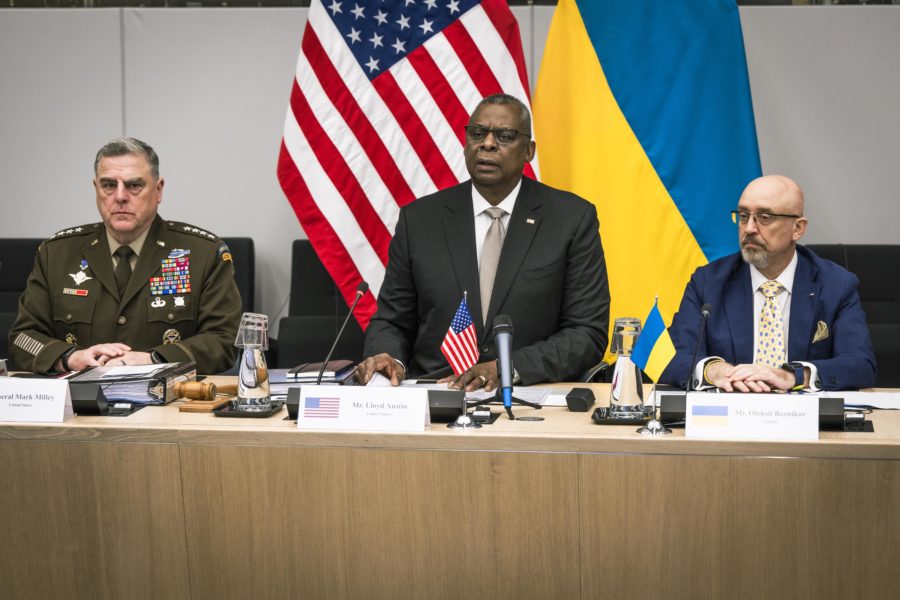The United States and allies will help Ukraine build a more comprehensive air defense system to protect key targets from Russian attacks by cruise missiles, ballistic missiles, and aircraft, U.S. officials said Oct. 12.
“What Ukraine is asking for and what we think can be provided is an integrated air and missile defense system,” Gen. Mark A. Milley, Chairman of the Joint Chiefs of Staff, said as representatives from about 50 nations met in Brussels. “That doesn’t control all the airspace over Ukraine. But they are designed to control priority targets that Ukraine needs to protect.”
Russia launched a barrage of missiles and air strikes against a variety of civilian targets in Ukrainian cities, including its capital, Kyiv, on Oct. 10 in retaliation for the bombing of a key bridge linking Russia to the occupied Crimean peninsula.
“These attacks killed and injured civilians and destroyed targets with no military purpose,” President Joe Biden said in a statement, calling the Russian strikes “utter brutality.”
Ukraine renewed its plea for better air defense systems to protect the population following the attacks, and the so-called Contact Group countries responded favorably.
U.S. Secretary of Defense Lloyd J. Austin III said help will come soon. “The systems will be provided as fast as we can physically get them there,” Austin said at his news conference with Milley. “We’re going to do everything we can, as fast as we can to help the Ukrainian forces get the capability they need to protect the Ukrainian people. That’s very, very important to us.”
The allied officials did not say when such defenses might be put in place and acknowledged connecting different pieces from a myriad of nations would be a technical and logistical challenge and would require training of Ukrainian forces.
“The task will be to bring those together, get them deployed, get them trained because each of these systems is different,” Milley said.
Ukraine would also have to develop a detection and command and control system and link all the components together.
“It’s quite complicated from a technical standpoint,” Milley said. “It is achievable, and that’s what we’re aiming at.”
The U.S. leaders detailed several specific systems they said could help form the basis of Ukraine’s new air defenses, in addition to systems such as Soviet-era S-300 systems already in use that have “been very effective,” according to Milley. Advanced systems, such as the National Advanced Surface-to-Air Missile System (NASAMS) are already in the pipeline but will take years to be fully deployed.
For example, Milley noted the I-HAWK, a legacy U.S. Army medium-range surface-to-air system which he said the Ukrainian government has specifically asked for. Milley and Austin also mentioned Germany’s InfraRed Imaging System Tail (IRIS-T) system, which is now being delivered. The possibility of U.S.-made Patriot batteries and Israeli defenses was floated by Milley, though he acknowledged such systems were among those that could be used rather than concrete offers from a particular country. Ukraine has repeatedly asked for Patriot systems and Israel’s Iron Dome.
Some experts cautioned that it would be difficult to build an exhaustive air defense system for Ukraine and that an ad-hoc system would have to be adopted in practice.
“It may be something closer to interoperability, or frankly, it may just be instead of integration, aggregation,” Tom Karako of the Center for Strategic and International Studies said. “But it’s the right aspiration. The threat makes it necessary to think imaginatively about these things.”
Neither side has been able to control the skies over Ukraine with their air force, despite Russia’s overwhelming relative advantage as one of the world’s biggest air forces. U.S. leaders have noted that Ukraine’s ability to deny Russia air superiority has prevented Russia from making sweeping gains on the battlefield by taking out the Ukrainian military from the air and allowing Russian ground forces to operate unmolested.
Much of the world’s attention had shifted to the war of attrition occurring in the east and south of the country as Ukraine fights to regain control of its territory using artillery and ground forces.
Russia, however, possesses long-range weapons, primarily air-launched cruise missiles that it can fire from bombers inside Russian airspace, as well as ballistic missiles.
These missiles can make it through to targets inside Ukraine due to the lack of a comprehensive air defense system Ukraine’s allies now say they will work to help provide. Some defenses the U.S. supplied early in the war, such as man-portable Stinger missiles that can be fired at low-flying planes and helicopters, are useless in the face of the standoff weapons Russia is implementing. According to the U.S. and Ukraine, thousands of Iranian-made drones have also been ordered by Russia, though Ukraine has had better success against those weapons due to their slow speed and low attitude.
In the future, Ukraine wants a system that can defend against both planes and missiles at low, medium, and high attitude.
“It’s a mix of all these that deny the airspace,” Milley said. “You’re trying to create a defensive system.”
